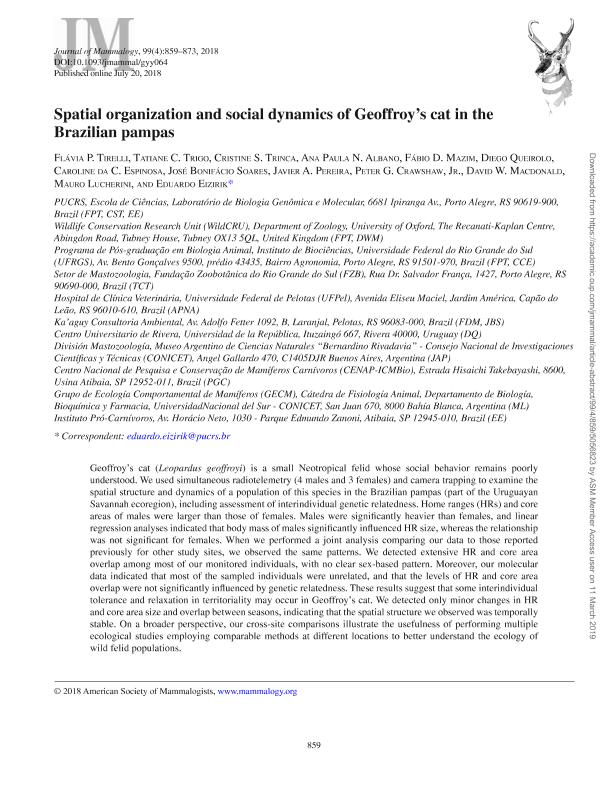Mostrar el registro sencillo del ítem
dc.contributor.author
Tirelli, Flávia P.
dc.contributor.author
Trigo, Tatiane C.
dc.contributor.author
Trinca, Cristine S.
dc.contributor.author
Albano, Ana Paula N.
dc.contributor.author
Mazim, Fábio D.
dc.contributor.author
Queirolo, Diego
dc.contributor.author
Espinosa, Caroline da C.
dc.contributor.author
Soares, José Bonifácio
dc.contributor.author
Pereira, Javier Adolfo

dc.contributor.author
Crawshaw, Peter G.
dc.contributor.author
Macdonald, David .W
dc.contributor.author
Lucherini, Mauro

dc.contributor.author
Eizirik, Eduardo

dc.date.available
2019-12-06T15:50:18Z
dc.date.issued
2018-07-20
dc.identifier.citation
Tirelli, Flávia P.; Trigo, Tatiane C.; Trinca, Cristine S.; Albano, Ana Paula N.; Mazim, Fábio D.; et al.; Spatial organization and social dynamics of geoffroy's cat in the Brazilian pampas; Alliance Communications Group Division Allen Press; Journal of Mammalogy; 99; 4; 20-7-2018; 859-873
dc.identifier.issn
0022-2372
dc.identifier.uri
http://hdl.handle.net/11336/91630
dc.description.abstract
Geoffroy´s cat (Leopardus geoffroyi) is a small Neotropical felid whose social behavior remains poorly understood. We used simultaneous radiotelemetry (4 males and 3 females) and camera trapping to examine the spatial structure and dynamics of a population of this species in the Brazilian pampas (part of the Uruguayan Savannah ecoregion), including assessment of interindividual genetic relatedness. Home ranges (HRs) and core areas of males were larger than those of females. Males were significantly heavier than females, and linear regression analyses indicated that body mass of males significantly influenced HR size, whereas the relationship was not significant for females. When we performed a joint analysis comparing our data to those reported previously for other study sites, we observed the same patterns. We detected extensive HR and core area overlap among most of our monitored individuals, with no clear sex-based pattern. Moreover, our molecular data indicated that most of the sampled individuals were unrelated, and that the levels of HR and core area overlap were not significantly influenced by genetic relatedness. These results suggest that some interindividual tolerance and relaxation in territoriality may occur in Geoffroy´s cat. We detected only minor changes in HR and core area size and overlap between seasons, indicating that the spatial structure we observed was temporally stable. On a broader perspective, our cross-site comparisons illustrate the usefulness of performing multiple ecological studies employing comparable methods at different locations to better understand the ecology of wild felid populations.
dc.format
application/pdf
dc.language.iso
eng
dc.publisher
Alliance Communications Group Division Allen Press

dc.rights
info:eu-repo/semantics/openAccess
dc.rights.uri
https://creativecommons.org/licenses/by-nc-sa/2.5/ar/
dc.subject
Body Mass
dc.subject
Home Range Overlap
dc.subject
Kinship
dc.subject
Leopardus geoffroyi
dc.subject.classification
Zoología, Ornitología, Entomología, Etología

dc.subject.classification
Ciencias Biológicas

dc.subject.classification
CIENCIAS NATURALES Y EXACTAS

dc.subject.classification
Ecología

dc.subject.classification
Ciencias Biológicas

dc.subject.classification
CIENCIAS NATURALES Y EXACTAS

dc.title
Spatial organization and social dynamics of geoffroy's cat in the Brazilian pampas
dc.type
info:eu-repo/semantics/article
dc.type
info:ar-repo/semantics/artículo
dc.type
info:eu-repo/semantics/publishedVersion
dc.date.updated
2019-10-24T18:21:45Z
dc.journal.volume
99
dc.journal.number
4
dc.journal.pagination
859-873
dc.journal.pais
Estados Unidos

dc.journal.ciudad
Lawrence
dc.description.fil
Fil: Tirelli, Flávia P.. Pontificia Universidade Católica do Rio Grande do Sul; Brasil. University of Oxford; Reino Unido
dc.description.fil
Fil: Trigo, Tatiane C.. Fundação Zoobotânica do Rio Grande do Sul; Brasil
dc.description.fil
Fil: Trinca, Cristine S.. Pontificia Universidade Católica do Rio Grande do Sul; Brasil
dc.description.fil
Fil: Albano, Ana Paula N.. Universidade Federal de Pelotas; Brasil
dc.description.fil
Fil: Mazim, Fábio D.. Ka’aguy Consultoria Ambiental; Brasil
dc.description.fil
Fil: Queirolo, Diego. Universidad de la República; Uruguay
dc.description.fil
Fil: Espinosa, Caroline da C.. Pontificia Universidade Católica do Rio Grande do Sul; Brasil
dc.description.fil
Fil: Soares, José Bonifácio. Ka’aguy Consultoria Ambiental; Brasil
dc.description.fil
Fil: Pereira, Javier Adolfo. Consejo Nacional de Investigaciones Científicas y Técnicas; Argentina. Museo Argentino de Ciencias Naturales Bernardino Rivadavia; Argentina
dc.description.fil
Fil: Crawshaw, Peter G.. Centro Nacional de Pesquisa e Conservação de Mamíferos Carnívoros; Brasil
dc.description.fil
Fil: Macdonald, David .W. University of Oxford; Reino Unido
dc.description.fil
Fil: Lucherini, Mauro. Universidad Nacional del Sur. Departamento de Biología, Bioquímica y Farmacia; Argentina
dc.description.fil
Fil: Eizirik, Eduardo. Pontificia Universidade Católica do Rio Grande do Sul; Brasil
dc.journal.title
Journal of Mammalogy

dc.relation.alternativeid
info:eu-repo/semantics/altIdentifier/doi/http://dx.doi.org/10.1093/jmammal/gyy064
dc.relation.alternativeid
info:eu-repo/semantics/altIdentifier/url/https://academic.oup.com/jmammal/article/99/4/859/5056823
Archivos asociados
